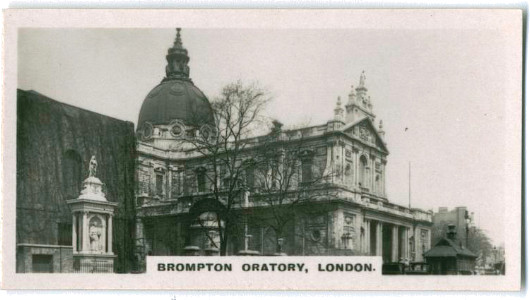2005 August
About Andrew Cusack
 Writer, web designer, etc.; born in New York; educated in Argentina, Scotland, and South Africa; now based in London.
Writer, web designer, etc.; born in New York; educated in Argentina, Scotland, and South Africa; now based in London. read more
News
Blogs
Reviews & Periodicals
Arts & Design
World
France
Mitteleuropa
Knickerbockers
Argentina
The Levant
Africa
Cape of Good Hope
Netherlands
Scandinavia
Québec
India
Muscovy
Germany
Academica
Lord Dacre
The Daily Telegraph‘s recent remembrance of Maurice Cowling relays the following tale:
Invitations to the club carried a seal reading: “I’d stake my reputation on it.” Dacre was said to have retaliated by comparing Cowling’s circle to “a band of social outcasts living in a mountain cave under the command of a one-eyed Cyclops”.
There’s nothing so spiteful as an academic rivalry! I remember meeting the late Lord Dacre in Oxford about two years before his death. He was by then an ancient man, and the organiser of the assembly tried to make us feel impressed and privileged that we were able to meet such a man. I’m afraid, however, we took advantage of the Baron’s poor hearing and kept on whispering to eachother “Don’t mention the Hitler diaries!” (in the manner of Basil Fawlty’s “Don’t mention the War!” on Fawlty Towers). What can I say, we were young. At any rate, I hope the Authenticators still exist.
The Story of Notre Dame de Bon Secours
The background story to Nôtre Dame de Bons Secours, from the Catholic Community Forum:
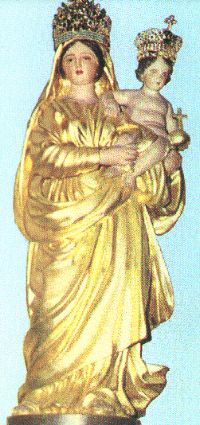 In 1727, French Ursuline nuns founded a monastery in New Orleans, Louisiana, and organized their area schools from it. In 1763 Louisiana became a Spanish possession, and Spanish sisters came to assist. In 1800 the territory reverted back to France, and the Spanish sisters fled in the face of France anti-Catholicsm. In 1803, short on teachers, Mother Saint Andre Madier requested reinforcements in the form of more sisters from France. The relative to whom she wrote, Mother Saint Michel, was running a Catholic boarding school for girls. Bishop Fournier, short-handed due to the repressions of the French Revolution, declined to send any sisters. Mother Saint Michel was given permission to appeal to the pope. The pope was a prisoner of Napoleon, and it seemed unlikely he would even receive her letter of petition. Mother Saint Michel prayed,
In 1727, French Ursuline nuns founded a monastery in New Orleans, Louisiana, and organized their area schools from it. In 1763 Louisiana became a Spanish possession, and Spanish sisters came to assist. In 1800 the territory reverted back to France, and the Spanish sisters fled in the face of France anti-Catholicsm. In 1803, short on teachers, Mother Saint Andre Madier requested reinforcements in the form of more sisters from France. The relative to whom she wrote, Mother Saint Michel, was running a Catholic boarding school for girls. Bishop Fournier, short-handed due to the repressions of the French Revolution, declined to send any sisters. Mother Saint Michel was given permission to appeal to the pope. The pope was a prisoner of Napoleon, and it seemed unlikely he would even receive her letter of petition. Mother Saint Michel prayed,
O most Holy Virgin Mary, if you obtain for me a prompt and favorable answer to this letter, I promise to have you honored at New Orleans under the title of Our Lady of Prompt Succor.
and sent her letter on 19 March 1809. Against all odds, she received a response on 29 April 1809. The pope granted her request, and Mother Saint Michel, commissioned a statue of Our Lady of Prompt Succor holding the Infant Jesus. Bishop Fournier blessed the statue and Mother’s work.
Mother Saint Michel and several postulants came to New Orleans on 31 December 1810. They brought the statue with them, and placed it in the monastery chapel. Since then, Our Lady of Prompt Succor has interceded for those who have sought her help.
A great fire threatened the Ursuline monastery in 1812. A lay sister brought the statue to the window and Mother Saint Michel prayed
Our Lady of Prompt Succor, we are lost if you do not come to our aid.
The wind changed direction, turned the fire away, and saved the monastery.
Our Lady interceded again at the Battle of New Orleans in 1815. Many faithful, including wives and daughters of American soldiers, gathered in the Ursuline chapel before the statue of Our Lady of Prompt Succor, and spent the night before the battle in prayer. They asked Our Lady for the victory of the American forces over the British, which would save the city from being sacked. General Andrew Jackson and two hundred men from around the South won a remarkable victory over a superior British force in a battle that lasted twenty-five minutes, and saw few American casualties.
It is still customary for the devout of New Orleans to pray before the statue of Our Lady of Prompt Succor whenever a hurricane threatens New Orleans.
Hat tip: Irish Elk. The image used below is of the National Shrine of Our Lady of Prompt Succor in New Orleans.
Notre Dame de Bon Secours, Pray for New Orleans!

Intercede for us with Jesus that we may always accept God’s graces and be found faithful to Him in our particular states of life. As you once saved our beloved City of New Orleans from ravaging flames, and our Country from an invading army, have pity on us and obtain for us protection from Hurricane Katrina and all other disasters.
Assist us in the many trials which beset our path through life. Watch over the Church and the Pope as they uphold with total fidelity the purity of faith and morals against unremitting opposition. Be to us truly Our Lady of Prompt Succor now and especially at the hour of our death, that we may gain everlasting life through the merits of Jesus Christ Who lives and reigns with the Father and the Holy Spirit, one God world without end.
Amen.
Rye Gothic
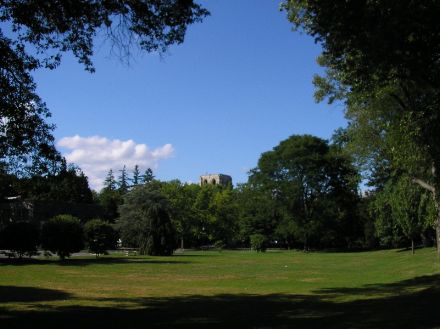
There’s a little portion of Rye on the Boston Post Road here in Westchester which is a veritable Gothic wonderland. From the south it begins on Rye High School’s beautiful campus with the track and playing field across a brook from the neo-Gothic middle and high school buildings, with sympathic additions covered in the same stone. Immediately to the north is the Victorian Gothic Rye Presbyterian Church, built in 1870 by architect Richard Upjohn, whose son and grandson designed two later additions, respectively. Just north of Rye Presbyterian is the Church of the Resurrection, and a little further north of that is Christ’s Church Rye, both of which are in the Gothic style.
The photo above shows the top of the crossing tower of the Church of the Resurrection, a 1930 structure built for Rye’s Catholic parish, viewed from Milton Road. I popped round to the area today and took a few photos, though I did not go inside Resurrection, as there was a wedding taking place. (more…)
The Winding Down of Summer
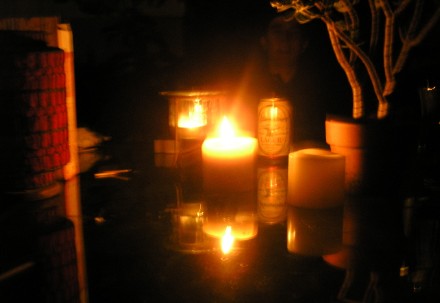
The summer pretty much began in Caroline Gill’s garden, and thus it appropriately played host to a little gathering last night as the season of leisure winds down. The Gills held a splendid little dinner al fresco including Mr. and Mrs. Gill, Caro, Michelle Carroll, yours truly, Mr. and Mrs. Kellogg and their son Doug, who I believe was Caro’s escort when she debuted. (I was unavailable since I was in Scotland at the time, which has been the cause of perennial complaints by Caro). Young Lizzie was absent for the meal but showed up later on in the evening.
Making fun of Caroline is an honored pasttime of mine, and one in which I revel. The Gill household is one in which friendly banter thrives. Last night I also got a chance to inform Mr. Gill that there are innumerable young men in Westchester who consider him something of an icon, and seek to imitate his leisurely lifestyle. Caro complains that I talk to her dad more than to her, which is only half true of course.
Speaking of dads, the aforementioned Michelle Carroll’s pop took her, Helen Clarke, and I out to dinner the night before ‘Hell’s Bells’ (as we sometimes call Helen) fled back to college in Ohio. He took us to a little gem of a place on the New York side of the Byram river in Portchester. Between dinner and dessert, Helen and I walked over the bridge to Connecticut just so I could say as we went back in “sorry we took so long, we went to Connecticut to have a cigarette.”
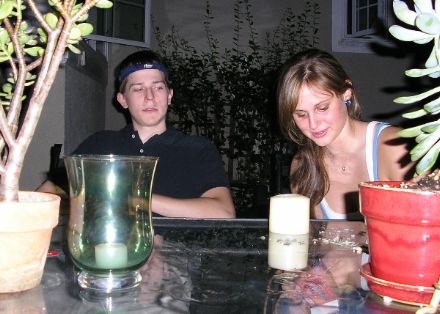
Doug eyes Lizzie’s match-fiddling with suspicion.
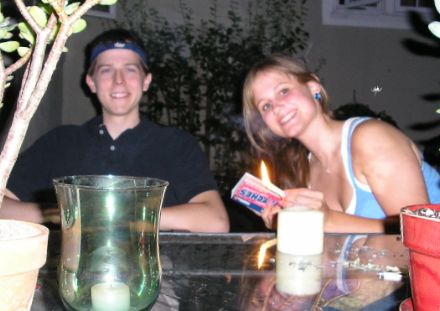
Smiling young Elizabeth about to set her hair alight.

Caroline Gill, brought to you by Poland Spring (“what it means to be from Maine”).
The Mace of the Palmetto State
THE HOUSE OF REPRESENTATIVES OF SOUTH CAROLINA
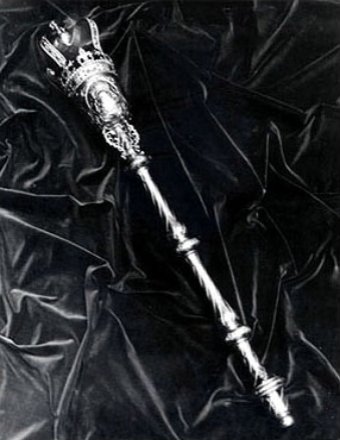
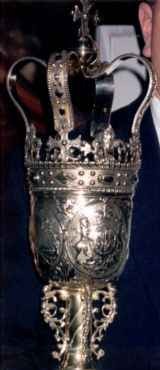 The mace currently used by the lower house of the General Assembly of South Carolina is another fine example of pre-revolutionary legislative regalia. It is a reminder of tradition in a state which takes great pride in its history and heritage. Furthermore, this ancient inheritance is still in everyday use. In 1880 the tradition of the Speaker’s procession was restored and since that year every legislative day has begun with the mace being borne by the Sergeant-at-Arms of the House, followed by the Speaker. When the Speaker reaches his chair in the House chamber, he exchanges bows with the Sergeant-at-Arms, who then places the mace upon its holster before the rostrum, exchanges bows with the Speaker once more, and thence the legislative day is called to commence. Whenever the House and Senate meet in joint session, the Mace is carried at the head of the procession.
The mace currently used by the lower house of the General Assembly of South Carolina is another fine example of pre-revolutionary legislative regalia. It is a reminder of tradition in a state which takes great pride in its history and heritage. Furthermore, this ancient inheritance is still in everyday use. In 1880 the tradition of the Speaker’s procession was restored and since that year every legislative day has begun with the mace being borne by the Sergeant-at-Arms of the House, followed by the Speaker. When the Speaker reaches his chair in the House chamber, he exchanges bows with the Sergeant-at-Arms, who then places the mace upon its holster before the rostrum, exchanges bows with the Speaker once more, and thence the legislative day is called to commence. Whenever the House and Senate meet in joint session, the Mace is carried at the head of the procession.
When the House is invited by the Senate to ratify passed legislation, the Sergeant-at-Arms bears the mace before the Speaker and the Clerk of the House in a solemn procession through the corridors of the State House, across the rotunda to the Senate chamber. There, it is put in a holding place just below the Sword of State, symbol of authority in the Senate and interesting in its own right, while the Speaker of the House, the President of the Senate, and the Clerks of both houses sign the acts. (more…)
Bisset versus the Banana
My fellow St Andrean Andrew Bisset reports in from auld Caledonia, recently incapacitated by a banana:
Deserved indeed!
Mary Queen of Scots’ Tree
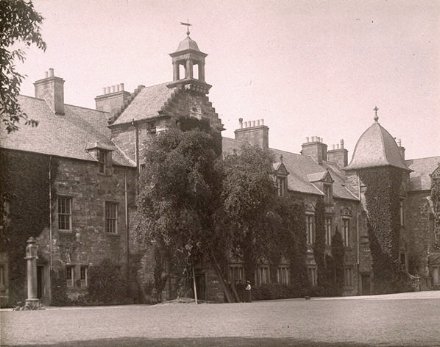
Pursuant to conversations held yesterday afternoon, I give you the thorn tree in the quad of St. Mary’s College, University of St Andrews, planted by Mary Queen of Scots. This photo was taken in the 1930’s, I believe. It looks a little worse for wear these days; rather sickly actually. Wouldn’t be surprised if the University was trying to kill it off as a safety hazard or other such bureaucratic flopdoodle.
Polo
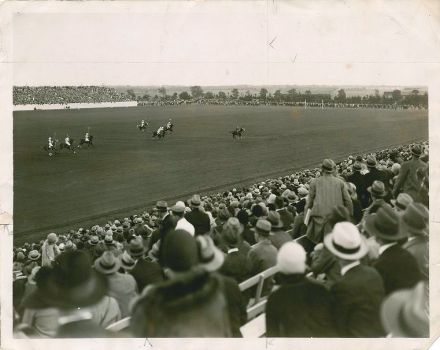
Second international polo match between the United States and the Argentine Republic, 1928.
First Day on the Job

WHA-PSH! WHA-PSH! Behold! The sound of the whip cracking as slavedriver James Panero, associate editor of the New Criterion corrals the newly-minted intern towards his desk. Not even a cubicle! Yes, dear reader, today we started our month-long internship at the venerable institution which the Times Literary Supplement says is “more consistently worth reading than any other magazine in English”.
“File these press clippings!” the seersuckered Mr. Panero commands. “Update the website! Polish the bust of Hilton Kramer! You will KNEEL when Roger Kimball speaks to you!” “Actually, he prefers grovelling,” Dawn Steeves chimes in, ever helpful.
No, no, dear reader, I jest. It is a good office with kindly folk. Roger Kimball even remembered that Russell Kirk went to St Andrews. The building was designed by Stanford White, no less, and is on the same block as the Theodore Roosevelt Birthplace Museum. The office features nice wooden floors, a Persian carpet, and a window specifically designated for Judge Bork to smoke out of when he visits, not to mention a dazzling array of books and periodicals to tempt the studious intern from his internical duties. James Panero and Stefan Beck are apparently working on an anthology of the Dartmouth Review‘s best (TDR is sort of the Neo-Hantonian version of the Mitre, or perhaps vice versa). But we mustn’t turn this into the “weblog” that squeels on the daily habits of todos los Nueva Criterionistas.
The only down side is that I had to pull out of the Leviathan Club trip to Maine. It would be rather nice to spend the days drinking champagne on a rowboat in the middle of a lake pretending to fish, but come on folks, we’ve got high culture to think about here. I hope the other Leviathanonians are enjoying themselves, and spreading the spirit of Gumpus to more northerly climes.
And to think, I used to believe that internships were for suckers. What? Work and not get paid? AH-HAhahaha! Go right ahead, while I take leisurely sips of my gin-and-tonic as I rest salubriously upon the hammock in my garden dabbling in F. Scott Fitzgerald and some Italian detective novels! Well, needless to say, I now realize that internships are not for just suckers. Nay, they are also for charitably-minded individuals who would like to devote some of their free time towards the advancement of Western civilization. Happily, the latter description aptly suits yours truly. I look forward to another day as the lowest rating aboard the S.S. New Criterion. Criterion Nova floreat!
The Church of St Agnes
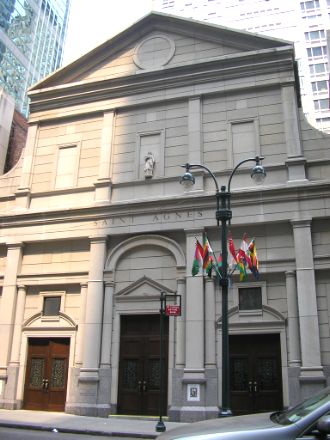
For those who have not seen St Agnes since it was rebuilt in a different style I thought I’d post a few photos I took after the 12:30 mass today. I don’t recall who the architect was; I believe it might be Thomas Gordon Smith. The reason for the vexilla-ed lampost is that East 43rd Street, in addition to being known as “Archbishop Fulton J. Sheen Place”, is also “U.N. Way” since the headquarters of that organisation terminates the vista eastwards. (more…)
Forty-fourth Street

I caught this glimpse of an apartment building on 44th St today, and rather enjoyed the uniform appearance of the glassed-in terraces, later additions I imagine.
Walsingham Tabernacle

I had not noticed that the tabernacle in the brand new Church of Our Lady of Walsingham in Houston, Texas was a smaller replica of the Ark of the Covenant.
Rather appropriate, considering one of Mary’s titles is ‘Ark of the New Covenant’.
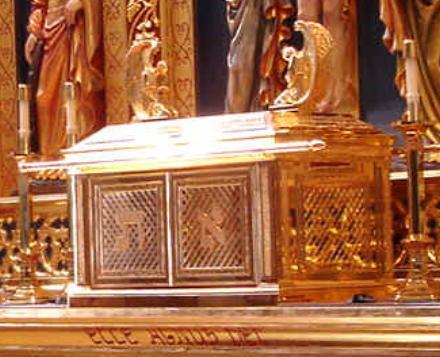
If London Were Like Venice
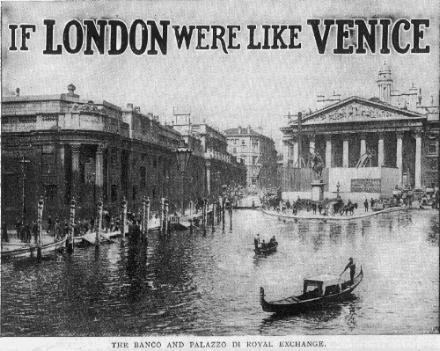
No doubt you remember If London Were Like New York, now we bring you If London Were Like Venice. A rather charming improvement, in my opinion. (more…)
Queens College
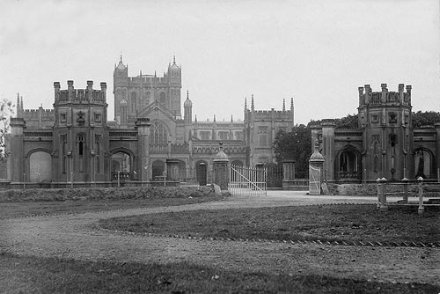
Queens College in Benares, India. Has a rather haunted feel to it in this photo.
St. Edith Stein: Martyr for Truth
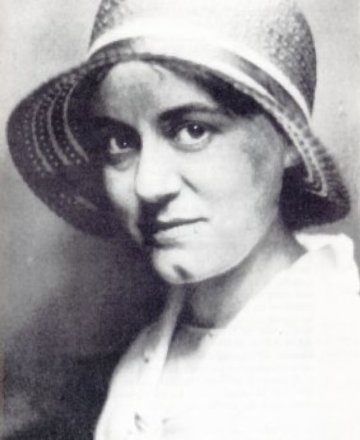
The 20th witnessed great advances in science and medicine. But it was not an era for truth. Research uncovered remarkable facts about the physical world, but philosophers and even average people were gripped by the idea that we cannot know anything for certain. Today, many — especially the most educated — allow that we all have notions of true and false, right and wrong, but that no one can claim anything is really the truth.
It is a hopeful sign, then, is that one 20th-century martyr made an extraordinary journey through modern uncertainties, and not only embraced, but was willing to die for the truth of the Catholic Faith.
Edith Stein was born to a well-off Jewish family in Breslau, Germany. Her father died when she was very young, and her mother was a very devout Jew and powerful woman. Edith early showed exceptional intelligence and, when few women pursued higher education, enrolled at the university. Along the way, she had lost her childhood Jewish faith, but her studies were to lead her to quite an unexpected rediscovery of God. [Continue]
Edith Stein — Convert, Nun, Martyr
Edith Stein is one of those people whose entire life seems to be a sign. She was born on Yom Kippur, the Jewish Day of Atonement, in 1891 in Breslau, Germany (now Wroclaw, Poland), the youngest of eleven children in a devout Jewish family.
When she was not yet two years old her father died suddenly, leaving Edith’s mother to raise the seven remaining children (four had died in childhood) and to manage the family business. Brought up on the Psalms and Proverbs, Stein considered her mother a living example of the strong woman of Proverbs 31, who rises early to care for her family and trade in the marketplace. By her teenage years, Stein no longer practiced her Jewish faith and considered herself an atheist, but she continued to admire her mother’s attitude of total openness toward God. [Continue]
More:
Carmelite Saints – The Life of Edith Stein
Edith Stein: A Brilliant Scholar Called to Share in Both the Virtue and Martyrdom of Christ
Women for Faith and Family – Saint Edith Stein (includes collect prayer, reading, and homily from canonization by John Paul II)
Association of Hebrew Catholics
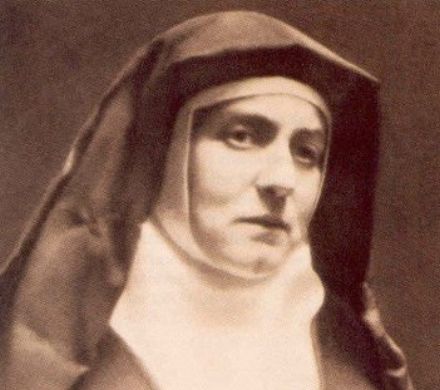
The Church in China
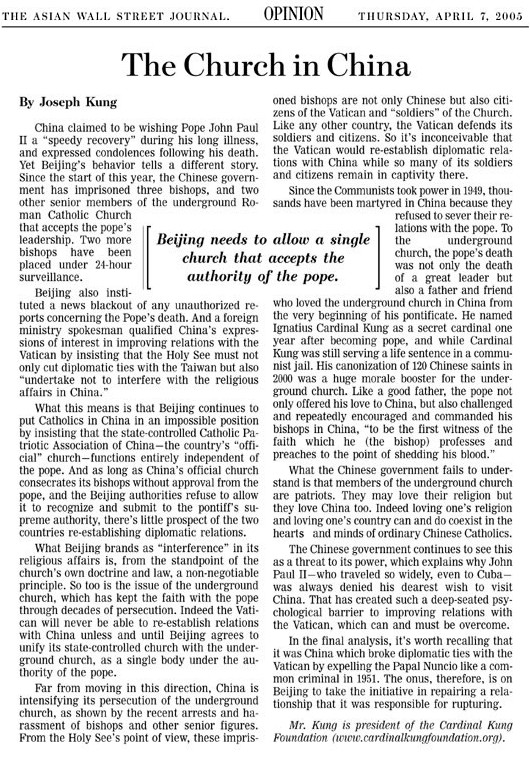
C.f. the Cardinal Kung Foundation.
Crossword Woes

A view of yours truly last night at the Leviathan Club taking a stab at the crossword in the New York Observer. It was a vicious crossword which I found impossible to complete. Vicious, wretched crossword.
Search
Instagram: @andcusack
Click here for my Instagram photos.Most Recent Posts
- Silver Jubilee November 21, 2024
- Articles of Note: 11 November 2024 November 11, 2024
- Why do you read? November 5, 2024
- India November 4, 2024
- The Lithe Efficiency of the Old Constitution November 4, 2024
Most Recent Comments
Book Wishlist
Monthly Archives
Categories

